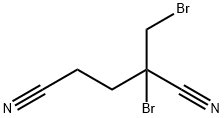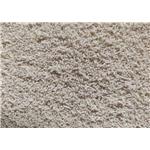Description
1,2-Dibromo-2,4-dicyanobutane is the main sensitizer of Euxyl K400, a widely used preservative agent in cosmetics, toiletries or metalwork fluids.
Methyldibromo glutaronitrile (MDBGN), also known as dibromocyanobutane, is to be found in the preservative system Euxyl K 400 (also called Tektamer 38), which is a mix of MDBGN and phenoxyethanol in a ratio of 1:4. Euxyl K 400 is a broad‐spectrum preservative with activity against fungi and bacteria. MDBGN is nearly always the allergen when sensitization to Euxyl K 400 occurs.
Chemical Properties
Light yellow crystalline solid or powder.
Commercial products may be soluble concentrate (liquid or
solid); pellets/tablets. Mild, acrid, sweet odor.
Occurrence
MDBGN was historically widely used in cosmetics, sunscreens, shampoos, liquid soaps, and barrier and moisturizing creams used at work. Other sources include moistened toilet tissues, ultrasound gel, adhesives, soluble cutting oils, latex paints, vaginal examination gel and sanitary pads. The EU ban has reduced these exposures very signifi cantly. Nevertheless, its inclusion in products used in the workplace such as barrier creams and after‐work creams makes its inclusion in the European and BSCA baseline series still relevant at the current time.
Uses
1,2-Dibromo-2,4-dicyanobutane is a preservative for metalworking fluids, cosmetics, adhesives, latex emulsions and paints, dispersed pigments and detergents; active ingredient in Euxyl K 400 and Tektamer 38.
Definition
ChEBI: An organobromine compound that consists of pentanedinitrile bearing bromo and bromomethyl substituents at position 2.
General Description
Crystals with a pungent odor. Insoluble in water. Used as a preservative in latex paint, adhesives, etc.
Air & Water Reactions
Insoluble in water.
Reactivity Profile
DBDCB may polymerize in the presence of metals and some metal compounds. Incompatible with acids; mixing nitriles with strong oxidizing acids can lead to extremely violent reactions. Nitriles are generally incompatible with other oxidizing agents such as peroxides and epoxides. The combination of bases and nitriles can produce hydrogen cyanide. Nitriles are hydrolyzed in both aqueous acid and base to give carboxylic acids (or salts of carboxylic acids). These reactions generate heat. Peroxides convert nitriles to amides. Nitriles can react vigorously with reducing agents.
Agricultural Uses
Microbiocide: Tolerances have been established by the U.S. Food
and Drug Administration when this substances is used as
a preservative in food-grade adhesives and as a slimicide
in the manufacture of food-grade paper and paperboard.
Used to control slime-forming bacteria and fungi in recirculating
water cooling system; oil-recovery drilling mud
systems; paper mill and pulp mill water systems and similar
industrial processing and chemical systems.
Trade name
BIOCHEK®; BIOCLEAR®; MERCK®
48051; METACIDE® 38; METASOL; TEKTAMER
Contact allergens
Methyldibromo glutaronitrile is a biocide widely used as a preservative agent in cosmetics, toiletries, and metalworking fluids. It is a potent allergen, banned in all cosmetics in the EU since 2007.
Safety Profile
Experimental
reproductive effects. When heated to
decomposition it emits toxic fumes of NO,
and Br-.
Potential Exposure
Nitrile microbiocide used as a preser-
vative in food grade adhesives and as a slimicide in the
manufacture of food grade paper and paperboard; used to
control slime-forming bacteria and fungi in recirculating
water cooling system; oil recovery drilling mud systems;
paper mill and pulp mill water systems and similar indus-
trial processing and chemical systems.
Shipping
UN3261 Corrosive solid, acidic, organic, n.o.s.,
Hazard class: 8; Labels: 8-Corrosive material, Technical
Name Required. UN3439 Nitriles, solid, toxic, n.o.s.,
Hazard Class: 6.1; Labels: 6.1-Poisonous materials,
Technical Name Required.
Incompatibilities
Corrosive. Strong oxidizers and reducing
agents, strong acids and bases. Reacts with acids, steam,
warm water producing toxic and flammable hydrogen cya-
nide fumes. Hydrogen cyanide is produced when propioni-
trile is heated to decomposition. Nitriles may polymerize in
the presence of metals and some metal compounds. They
are incompatible with acids; mixing nitriles with strong
oxidizing acids can lead to extremely violent reactions.
Nitriles are generally incompatible with other oxidizing
agents such as peroxides and epoxides. The combination of bases and nitriles can produce hydrogen cyanide. Nitriles
are hydrolyzed in both aqueous acid and base to give car-
boxylic acids (or salts of carboxylic acids). These reactions
generate heat. Peroxides convert nitriles to amides. Nitriles
can react vigorously with reducing agents. Acetonitrile and
propionitrile are soluble in water, but nitriles higher than
propionitrile have low aqueous solubility. They are also
insoluble in aqueous acids
.
Waste Disposal
Recycle any unused portion
of the material for its approved use or return it to the manu-
facturer or supplier. Ultimate disposal of the chemical must
consider: the material’s impact on air quality; potential
migration in soil or water; effects on animal, aquatic, and
plant life; and conformance with environmental and public
health regulations
.





